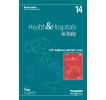Health & Hospitals in Italy. 14th Annual Report 2016
Synopsis
Pubblicato con licenza Creative Commons Attribuzione-Non Commerciale-Non opere derivate 3.0 Italia (CC-BY-NC-ND 3.0 IT) nella collana Aiop - Associazione italiana ospedalità privata - Open Access
The 2016 Health & Hospitals Report focuses, as it does every year, on the progress of the Italian hospital system: a system comprisiing 1,100 healthcare institutions with 200,000 patient beds, more than 9 million hospitalizations per year and 630,000 employees. All of this operates with a total hospital expenditure of EUR 61.2 billion, corresponding to 54.3% of the EUR 113 billion public health expenditure.
It is a complex system of services that meets the people’s needs and demands for care and assistance and the reason why the Report always presents two aspects: that of users and citizens and that of the “machine”, whose financial and management features relate to a mixed public/accredited private system, defined by an established law that now dates back to 25 years ago and is perceived, as well as experienced, as such by Italians.
This year it was decided to detect the effects of a “process of accumulation” of official and de facto financial and operational measures that over the past few years have resulted in placing the difficulties of restructuring and reorganization the public hospital system onto the users: through higher charges and access restrictions for users who have reacted by seeking out alternative solutions in the private sector as well as in hospital facilities outside their home region, or even by deciding to postpone or forego treatment. The result has been an increased sense of loss of integrity in the universal and
inclusive principle upon which our National Health Service is based (or should be based), and the danger of a future deterioration in citizen health outcomes given the current difficulties for access and the progressive population aging process.
And this is taking place while there are still areas of “Additional Revenues” from the insufficiently transparent funding to public Hospital Centers and directly-managed Hospitals, that may be used to cover implicit budget deficits. Whereas, on the contrary, these could free up resources for the improvement of equipment, organization and especially services for users.
The path is getting narrow and the need for a major overhaul of the public hospital system (and the entire health system) is becoming increasingly clear, as is the fact that the inherent difficulties of this profound change cannot be passed on to users and accredited private service providers. The National Health System is a fundamental public asset, but there is a clear need for it to undergo repairs that include the redefinition of its priorities, more efficient use of available resources, and consideration of the consequences of today’s actions on the health of citizens in the medium term.
Downloads


